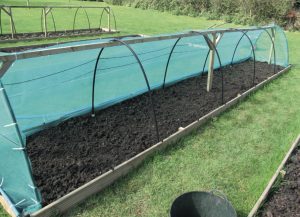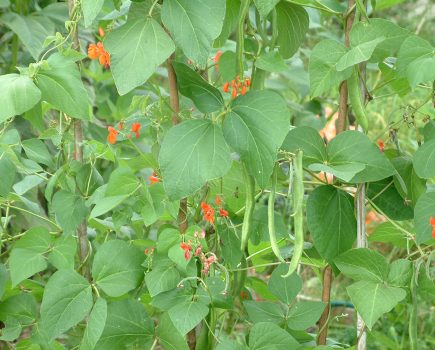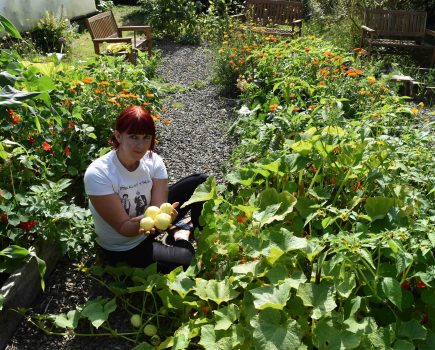In this article extract taken from the August issue of The Country Smallholder magazine, Fiona and Hugh Osborne (pictured above) extensively use fruit and vegetable cages to protect valuable crops.
As soon as we started growing significant quantities of fruit and vegetables, we found that lots of other creatures liked them too! We lost entire crops of cabbages to caterpillars, berries to birds and even strawberries to mice and voles.
Whilst we found it possible to pick off occasional caterpillars, the the more crops we grew, the harder that job became. Running around waving our arms at birds eating our blackcurrants wasn’t effective for even a small number of bushes and canes. As we expanded our activities, we realised that we needed to take action as our losses were unsustainable.
We did talk to farmer friends as to what they used. At the time insecticides were widespread in protecting brassicas. Whilst that seemed an easy solution, we were slightly alarmed about the warning on some long-lasting treatments such as “If you use this stuff, you must plant out using gloves as it’s dangerous if you get it on your skin”.
The idea of not touching the food that we intend to eat later because of the toxicity of the treatment just wasn’t for us so we decided to look for other solutions. Ultimately, we settled on physical barriers in the form of fruit and vegetable cages.
 ROW COVERS
ROW COVERS
Our first experiments in crop protection followed the approaches common to most gardeners and allotmenteers, net supported on hoops to cover annual crops of cabbages, cauliflowers and over young lettuces and peas to keep the dratted wood pigeons off!
These systems work well and have the great advantage of being cheap, simple to install and easy to move from place to place. We did find quickly that the choice of a supporting frame made a huge difference to the longevity of our covers and cages. Wood tended to rot. Stiff fence wire worked well for short term row covers on young peas, lettuces etc. and would easily thrust into the soil. On longer term installations though the wire would tend to rust, and it was often not sufficiently strong for taller covers for Brussel sprouts and the wire bent in the wind (or when pigeons landed on it).
An allotments owner and plumber showed us their solution – MDPE pipe! This is the stuff often found as blue water pipe and in various other guises. He was able to source offcuts from building projects and cut them to three metre lengths that made brilliant supports for netting. He got some for us that is now over 15 years old and looks like new, its brilliant stuff and often available for free from friendly plumbers or (with permission) from skips.
It’s even not too expensive if you have to actually buy a roll (he says, making the sign to ward off evil!). The same chap clued us into a great source of insect netting, green “debris net” often used on building sites. This is a very fine mesh, more than fine enough to keep out butterflies and other harmful insects. It comes in 3m wide rolls which is wide enough to cover a four foot wide vegetable bed to a good height.
It partners well with the MDPE pipe in that there are often lengths left over after building projects and a polite request accompanied by a home-made cake will often secure generous amounts from friendly builders. Once we started using vegetable covers, we found that having standardised vegetable beds made life much easier.
The same lengths of pipe fit every spot as we rotate crops and succession plant – we can’t tell you how important that is. The nets are always the right length and we keep a bucket of metal tent pegs to peg down the bottom. BUT we found that as easy as it is to just thrust pipes into the ground, throw a cover over and peg it down, it didn’t make for easy, regular access.
Where we tried to use this technique on our strawberry beds, we found access a problem. During harvest season, we needed to get into the strawberry beds several times a week to pick the ripening fruit and, whereas taking a cover off once to harvest a few caulis was fine, unpegging the whole arrangement every other day was a major grind! Much head scratching and planning followed, and we consulted the John Seymour book “The SelfSufficient Gardener” (sadly out of print now but you can find it second hand).
In the book he describes complete moveable frames. This wasn’t quite right for us, but we figured out that we could build a moveable attachment to our raised beds where the bottom of each net would be attached to more MDPE pipe that simply clipped to saddle clips attached to the frame of the raised bed. To open this frame all we had to do was grasp the bottom of the net and pull so it would unclip. We used debris netting for full bed insect covers or wider bird mesh for strawberries – this would allow insects in but keep birds off the fruit.
This article extract was taken from the August edition of The Country Smallholder. To read the article in full you can buy the issue here.
To receive regular copies of The Country Smallholder magazine featuring more articles like this, subscribe here.
For FREE updates from the world of smallholding, sign up for The Country Smallholder newsletter here.








